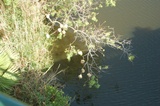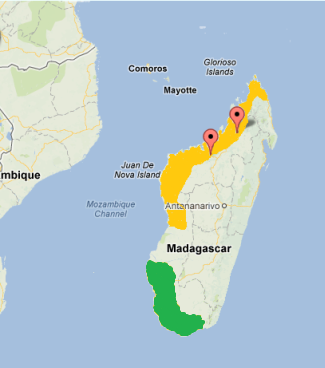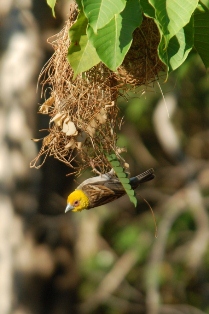Weaver species
Choose different species from drop-down list and press 'Go' button. See Full species list.Sakalava Weaver Ploceus sakalava
IUCN: Least concern Discovery: 061Categories: long tube, island, baobab, nectar, palm, double nests, blue eggs,
News items about species
Discovery
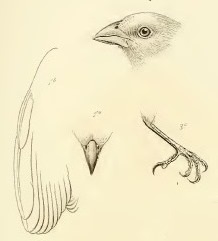
figure from Edwards (1879) 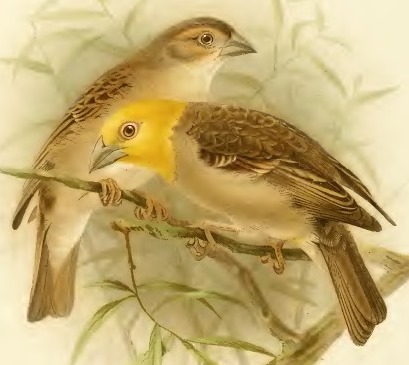
figure from Edwards (1879) 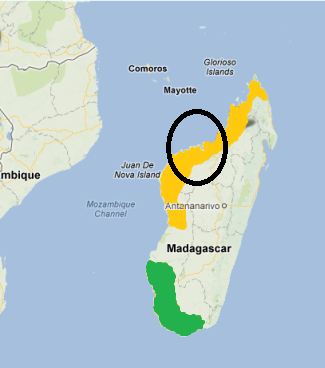
distribution, type locality circled IntroductionThe Sakalava Weaver was formally described by Karel Johan Gustav Hartlaub, a German physician and ornithologist.The Sakalava Weaver had been collected by Victor Sganzin, a French naval officer and zoologist. Sganzin was appointed as military administrator of the French outpost at Sainte Marie island (Madagascar), and he explored the Malagasy fauna from 1831-1832 (Sganzin 1840), collecting many bird specimens. When Sganzin returned to the Cape, he gave the Sakalava Weaver specimen to Jules Verreaux (at the South African Museum). It must have been sent to the British Museum at some stage. It was overlooked as a new species for many years, until the head ornithologist of the British Museum, George Robert Gray, pointed it out to Hartlaub (Hartlaub 1867), who was writing about the birds of Madagascar (Hartlaub 1861). The first illustrations of the Sakalava Weaver were published by Edwards (1879). The first plate contained line drawings of the wing, head, bill and foot. This was followed by a colour plate of a male and female. Scientific citationPloceus sakalava Hartlaub 1861, Beitr. Faun. Madag., p.54 Madagascar.Meaning of namessakalava - After the Sakalava ("people of the long valleys"), a native clan of Madagascar whose kingdom, established in the sixteenth century, was subdued in 1824 and incorporated into a united Madagascar.First English nameSakalava Weaver-bird (Sibree 1891), decades after it was first described.Alternate namesSakalava Fody.CollectorVictor Sganzin.Date collected1831-32.Locality collectedMadagascar.Type specimensThe type specimen is in the British Museum (BM 1845.7.6.10). |
The above is based on Weaver Wednesday 2, a weekly series about the discovery of each weaver species.
This species text first appeared as
Weaver Wednesday [178] - Discovery [61]: Sakalava Weaver on 2015-11-11
1. Basic biology
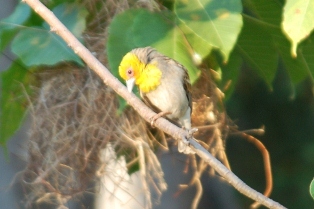
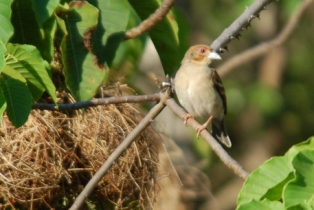
Identification. The Sakalava Weaver is a colonial weaver found in the drier western parts of Madagascar. The adult male in breeding plumage (photo above left has a yellow head to upper breast, clearly separated from a pale belly and nape. The wing coverts have buffy-white tips forming a wingbar. The iris is brown with bare reddish skin around the eye. The non-breeding male has the head grey, and the skin around the eye is pale pink. The female (photo above right is similar to the non-breeding male but paler. Young birds are green above, yellow below, and with a golden brown wash on the chin and throat.
This species is one of 3 weaver species to have a bare skin patch around the eye (the others are the White-headed Buffalo-weaver and the Baya Weaver). Distribution.
Two subspecies of the Sakalava Weaver are recognised (see map right, based on Handbook of the Birds of the World, Vol. 15, and showing the current PHOWN records: Habitat. The Sakalava Weaver is found in open country in drier lowlands, often in areas cleared for human settlement; also found in spiny-bush areas, and dry deciduous forest. Food. The Sakalava Weaver is mainly granivorous, including some rice. It also regularly feeds on insects and spiders, especially when feeding young. It also feeds on flowers. Breeding.
The Sakalava Weaver is apparently mainly monogamous, with some males perhaps being polygynous. This species is colonial, with 10-120 nests at a site, and up to 40 nests in one tree.
The nest (photo left, additional photo from colony at phown 76) is built by both sexes. The nest is retort-shaped, with an entrance tunnel 17-40 cm long. It is placed 2-25 m above the ground and usually in a palm, boabab or exotic Gyrocarpus americanus. The nest is sometimes attached below or near the nests of crows or raptors, eg. Madagascar Buzzard Buteo brachypterus (see phown 1489). Nests may also be suspended from the thatched roof of a village house. Males sleep in non-breeding nests during the breeding season. Clutch size is 2-4 eggs, incubation is by the female, and chicks are fed by both parents. Nests are preyed on by Madagascar Harrier-hawk Polyboroides radiatus, and eggs have been taken by the Common Brown Lemur Eulemur fulvus. Old nests may be used for breeding by the Madagascar Bibfinch Lepidopygia nana. |
The above is based on Weaver Wednesday, a weekly series about weaver species.
This species text first appeared as
Weaver Wednesday [30]: Sakalava Weaver on 2013-01-09
2. Breeding facts
| Pair bond Apparently primarily monogamous, some males perhaps polygynous Breeding season Timing may be detemined by local rainfall, Sept-Oct in N Madagascar and Nov-Apr in W; in more arid SW irregular, starting as early as Aug or as late as Dec Nest site placed 2-25 m above ground and usually in palm or tree, including boabab (Adansonia) and exotic Gyrocarpus americanus; or suspended from thatched roof of village house Nest building built by both sexes Colony size Colonial, with 10-120 nests at a site, and up to 40 nests in single tree Clutch size 2-4 eggs Egg colour plain greenish-blue Egg size average size 20.5 x 15.1 mm Incubation incubation by female, no information on duration of incubation period Chicks and nestling period chicks fed by both male and female, no information on duration of nestling period |
Breeding information based on Handbook of the Birds of the World, Vol. 15.
3. Photos of Weaver Nests
 Vm 11906 |  Vm 11904 |  Vm 8405 |  Vm 8403 |  Vm 7278 |  Vm 7277 |
Thumb-nails of most recent PHOWN records - click on one to see its full record
See all PHOWN records for this species here.
PHOWN (Photos of Weaver Nests) provides valuable info on breeding distribution and colony sizes of weavers.
You can contribute by registering and submitting photos at Virtual Museum webpage.
4. Breeding distribution
Google map showing distribution (For species with small ranges you need to zoom in at the correct area to see the range):
yellow blob - range of weaver species; read more about this here.
![]() - PHOWN records with photos
- PHOWN records with photos
![]() - PHOWN records with no photos (Nest Record Cards, other records)
- PHOWN records with no photos (Nest Record Cards, other records)
![]() - Birdpix records
- Birdpix records
![]() - comments on out of range records, or interesting records
- comments on out of range records, or interesting records
![]() - type locality
- type locality
CLICK on the marker on the map to see individual record details.
5. Range changes
Not South African speciesThe above is based on Weaver Wednesday 3, a weekly series about range changes in South African weaver species.
This species text first appeared as
n/a








